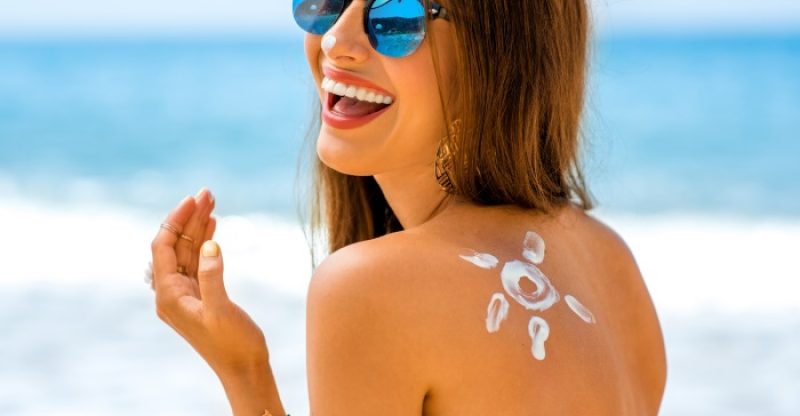Best and Worst Sunscreen of 2018 and Natural Alternatives
While it is undoubtedly true that you want to protect your skin from the sun’s harmful rays, it’s equally true that spending time outdoors and enjoying the sun in moderation has many health benefits.
The sun allows your body to make Vitamin D, which you use for many essential functions.
So, knowing how to protect your skin so that you can enjoy a day at the beach or a hike outdoors is essential knowledge.
Our guide to the best sunscreens is here to help.
We’ll give you the low-down on all our favorite brands, including the very best natural sunscreen options, plus help you make better choices about your sunscreen in the future.
It is an unfortunate fact that many sunscreens do not offer the protection they claim to provide.
Many sunscreens contain harmful chemicals or do not adequately protect your skin from the sun.
Thus, knowing how to select the right sunscreen can save your skin as well as your health.
To understand what makes a great sunscreen, we must first address how sunscreen works, to know which ingredients are indeed imperative and which are unnecessary in effective products.
Later, we’ll identify some excellent sunscreen options for both adults and children, and we’ll even share alternative sunscreens that use minerals instead of chemicals to block the sun.
Understanding Sunscreen
As a gel, lotion, spray, or wax, sunscreen is a mix of two types of compounds designed to
- Reflect or scatter sunlight away from your skin, as well as
- Protect your skin from UV rays by absorbing them. Most traditional sunscreens use inorganic chemicals to accomplish the first goal and organic ones for the second.
How Sunscreen Works
The inorganic compounds in sunscreen actually reflect light away from your skin, much like white paint reflects light.
Chemicals and minerals like zinc oxide and others are manufactured to come in very tiny particles so that we no longer see the white streaks of minerals on the skin of users like we did a few decades ago; the same action, however, is still taking place on your skin.
These compounds literally reflect light away so that it does not harm your skin.
The other type of compounds found in sunscreen are organic (carbon-based) and usually chemicals.
These are designed to absorb the harmful UV light that damages skin.
The molecules of these compounds absorb the UV radiation into their chemical bonds, releasing heat as they absorb, and slowly breaking down with more absorption.
This is one of the reasons you must reapply sunscreen when you are outside.
What is SPF?
The Sun Protection Factor, or SPF, that is now standard on sunscreen labels tells you how well that sunscreen will protect your skin from UVB, which is one type of UV radiation.
UVB is the type of sunlight that can cause your skin to burn and can eventually lead to several varieties of skin cancer.
Many people find it helpful to remember that the “B” in UVB reminds them not to Burn.
Sunlight also contains UVA radiation.
This wavelength of sunlight can penetrate deeper into your layers of skin, causes your skin to age more quickly, and also raises your risk for some forms of skin cancer.
Many sunscreens today offer what is called broad-spectrum blockage, which means they protect from both UVA and UVB rays.
But, since SPF is all about UVB, how do we know how well a sunscreen is protecting against UVA? The answer is, we don’t at this time.
There is no standard for identifying the UVA-blocking strength of a particular sunscreen.
Any compound that deflects sunlight will work on both UVA and UVB, but we have no system for measuring the quality or strength of UVA absorption by organic compounds.
The general recommendation is to use sunscreen that provides an SPF of at least 15, but ideally closer to 50.
Research indicates that sunscreens with SPF ratings higher than 50 are no more effective than those rated at SPF 50.
While no sunscreen alone can protect against 100 percent of UV rays, a sunscreen with an SPF of 30 blocks 97 percent of UV rays, which is a good start.
While sunscreen is very helpful when used correctly, many people don’t use enough sunscreen or do not reapply their sunscreen frequently enough to protect their skin adequately.
Sunscreen will wash off or rub off when touched, so it is essential that you reapply it every two hours.
For maximum protection, you should be using a full ounce, equal to a shot glass, to cover your body.
Choosing the Right Sunscreen
Sunscreen is very different than other types of beauty products, for many reasons.
The particles in sunscreen that are designed to reflect and absorb sunlight are so small that your body can absorb them; they can sometimes cross the blood-brain barrier, and they can be extremely harmful to aquatic life.
Sunscreen is also designed to be worn on your skin for long periods, with regular reapplication.
This is significantly different than other products that touch your body only briefly or are used on only small parts of your skin.
It is important that your sunscreen offer protection from both UVA and UVB rays.
While UVA damage is not as obvious as the sunburn caused by UVB rays, damage from UVA ages your skin and suppresses your immune system.
In addition, UVA damage has been linked to basal cell carcinoma, squamous cell carcinoma, and melanoma (1).
No sunscreen is going to be perfect and prevent exposure to all harmful rays from the sun.
But you can select safer sunscreens that include fewer or no harmful ingredients, and you can use other precautionary measures to protect your skin from sun exposure, too.
Remember that sunscreen will never block all of the harmful radiation the sun emits, so wearing long sleeves and pants, as well as hats, can further protect your skin from overexposure to UV radiation.
The sunscreen product you select is based mostly on your personal choice, and you may want to choose different products for different areas of your body.
For example, you may select a different product to use on your body than your face, especially if you are prone to acne. Some products work better in areas with lots of hair, like your scalp.
Here are some tips to consider when selecting a sunscreen product.
- Gels work well in areas with more hair, like a man’s chest or the scalp.
- Products in stick form are good for around the eyes, especially on children.
- While sprays are popular because of their ease of application, they are not always the best option. Make sure you are applying enough of the product to protect the skin and make sure you and your children are not inhaling the product, as it can cause respiratory problems. Never apply these products while smoking or near a flame or heat source.
- If you purchase a multi-purpose product, such as one that moisturizes and also provides SPF, you must reapply this in the same way you would sunscreen.
- Do not use products that combine sunscreen with insect repellant. While sunscreen should be reapplied every two hours, insect repellant should be used less frequently and more sparingly. It is better to use two separate products for these purposes.
- FDA labeling guidelines prohibit the use of terms like “waterproof” on sunscreens because it implies that the product will not come off in water. All sunscreens will eventually wash away if exposed to water. New guidelines state that sunscreens labeled as Water Resistant are effective in the water for up to 40 minutes, after which time they would need to be reapplied. Very Water Resistant on the label means it is effective for up to 80 minutes in the water. Always reapply sunscreen after getting out of the water or after sweating to maintain maximum protection.
- No matter what product you use, remember that sunscreen only works when it is applied generously and regularly.
Now, let’s take a look at the top-rated sunscreens available today, including those best suited for kids, as well as natural sunscreens that use minerals instead of chemicals.
The Best Sunscreens
The Environmental Working Group has been publishing an annual list of recommended sunscreens since 2008.
Their analysis includes examining the chemical makeup of each product, as well as examining the sun protection offered by each.
Other organizations, such as the Skin Cancer Foundation and the American Academy of Dermatology, also publish guidelines and recommendations regarding sunscreen.
The following are recommendations based on these and other sources to help you select quality products in these categories.
Sunscreens for Active Use
- All Good Sunstick, Unscented, SPF 30
- Attitude 100% Mineral Sunscreen, Fragrance-Free, SPF 30
- Aveeno Baby Continuous Protection Lotion Sunscreen, Sensitive Skin, SPF 50
- Badger Sunscreen Cream, Unscented, SPF 30
- Goddess Garden Organics Everyday Natural Sunscreen Lotion, SPF 30
- Kabana Organic Skincare Green Screen Sunscreen, Neutral, SPF 31
- Poofy Organics The Sunscreen Stick, SPF 30
- Sunology Natural Sunscreen, Face, SPF 50
- Thinksport Sunscreen, SPF 50+
- Zeb’s Organics Sunscreen, SPF 20 & 30
Moisturizers with Sunscreen
- Andalou Naturals BB Argan Stem Cell Benefit Balm, Un-Tinted, SPF 30
- Badger Damascus Rose Face Sunscreen, SPF 25
- Block Island Organics Natural Face Moisturizer, SPF 30
- Goddess Garden Organics Face the Day Daily Moisturizer, SPF 30
- Juice Beauty Oil-Free Moisturizer, SPF 30
- Suntegrity Skincare Natural Moisturizing Face Sunscreen & Primer, SPF 30
Kid-Friendly Sunscreens
- Adorable Baby Sunscreen, SPF 30+
- All Good Kid’s Sunscreen, SPF 30
- Badger Kids Sunscreen Cream, Tangerine & Vanilla, SPF 30
- BurnOut Kids Sunscreen, SPF 35
- California Baby Calendula Sunscreen, SPF 30+
- COOLA Suncare Baby Mineral Sunscreen Stick, SPF 50
- Equate Baby Zinc Sunscreen Mineral Lotion, SPF 50
- Hawaiian Sol Sol Kid Kare, SPF 50
- Kiss My Face Organics Kids Mineral Sunscreen, SPF 30
- MDSolarSciences KidCreme Mineral Sunscreen, SPF 40
- Nurture My Body Baby Organic Sunscreen, SPF 32
- Thinkbaby Sunscreen, SPF 50+
- Thinksport Kids Sunscreen, SPF 50+
- Tom’s of Maine Baby Sunscreen Lotion, SPF 30
- TruBaby Water & Play Sunscreen, SPF 30+
- TruKid Sunny Days Sport Sunscreen, SPF 30
Inexpensive and Widely-Available Sunscreens
Not all sunscreens are available at retailers, or for a reasonable price.
If you want to protect your skin but not break the bank, we have chosen some good bargains that still offer superior protection from UV rays.
These sunscreens all retail for between $10 and $20, they are highly rated by the Environmental Working Group or other agency, and they are widely available from many popular retailers.
- Aveeno Baby Continuous Protection Sensitive Skin Lotion Sunscreen SPF 50
- Babyganics Mineral Sunscreen Stick, SPF 50+
- Bare Republic Clearscreen Sunscreen Gel, Sport SPF 30
- Blue Lizard Australian Sunscreen, Baby SPF 30+
- CeraVe Baby Sunscreen Lotion SPF 45
- Neutrogena Pure and Free Baby Sunscreen SPF 50
Sunscreens to Avoid
Children need sun protection to prevent sunburns that can cause skin cancer and other problems later in life, but they are also more susceptible to chemicals and other compounds commonly found in sunscreens.
Avoiding certain sunscreens with children is always a good idea, as this will help protect both their skin and their future health.
Here are our lowest-rated choices for children.
Sunscreens to Avoid with Children
- Banana Boat Kids Continuous Spray Sunscreen, SPF 100
- Coppertone Water Babies Foaming Lotion Sunscreen, SPF 70
- Coppertone Kids Sunscreen Continuous Spray, SPF 50
- Coppertone Wet’n Clear Kids Sunscreen Continuous Spray, SPF 50+
- CVS Health Kids Clear Sunscreen Spray, SPF 50 & 70
- Equate Baby Sunscreen Lotion, SPF 70
- Neutrogena Pure & Free Baby Sunscreen, SPF 60+
- Neutrogena Wet Skin Kids Sunscreen Spray, SPF 70+
- Up & Up Kids Sunscreen Stick, SPF 55
Sunscreens to Avoid for Everyone
- Panama Jack Sport Sunscreen Lotion, SPF 85
- CVS Health Sun Lotion, SPF 60
- Up & Up Sport Sunscreen Spray, SPF 15, 30, & 50
- Panama Jack Sunscreen Continuous Spray, SPF 15, 30, & 70
- NO-AD Sun Care Sport Continuous Spray Sunscreen, SPF 50
- Neutrogena Ultra Sheer Sunscreen Spray, SPF 30
- Neutrogena Ultra Sheer Dry-Touch Sunscreen, SPF 70, 85+, & 100+
Understanding Natural Sunscreens
The majority of sunscreens available today use what is known as chemical barriers to UV radiation.
These sunscreen products use chemicals like oxybenzone, retinyl palmitate, octinoxate, octisalate, and homosalate to block or absorb the UV radiation from the sun.
Some of these chemicals have been linked to serious health concerns.
For example, oxybenzone has been identified as a potential estrogenic endocrine disruptor that can cause reproductive problems and has environmental concerns (2, 3).
In contrast, mineral-based sunscreens provide a physical barrier to UV rays using mineral agents such as zinc oxide and titanium dioxide.
These minerals provide broad-spectrum protection naturally, as they sit on top of the skin and create a physical barrier to the sun’s rays.
Mineral-based sunscreens contain no toxic ingredients or chemicals and are not absorbed into the skin, lowering the chance of irritation and other health problems.
The Best Natural Sunscreens
Among the natural sunscreens that are highly recommended, you will find no synthetic fragrances, chemicals, or toxins that can harm your skin or your health.
Here are our favorites.
- Badger All Season Face Stick SPF 35
- Suntegrity Skincare SPF 30 Natural Mineral Sunscreen For Body
- Babo Botanicals Clear Zinc Sport Stick Sunscreen Fragrance-Free SPF 30
- Thinkbaby Mineral Sunscreen Stick SPF 30
- Alba Botanica Sensitive Mineral Sunscreen Fragrance-Free Lotion SPF 30
- Drunk Elephant Umbra Sheer Physical Defense SPF 30
Getting Enough Vitamin D
Because your body needs sunlight to make Vitamin D, getting some sun exposure is necessary for overall health.
While you can get Vitamin D from the foods you eat, sun exposure is the most effective and efficient way to get your daily dose of Vitamin D.
Just ten minutes of sun exposure allows your body to create as many as 10,000 units of Vitamin D naturally.
Because a deficiency in Vitamin D is linked to many health problems, you want to find a balance between protecting your skin and getting enough Vitamin D.
Lack of sufficient Vitamin D can lead to autoimmune diseases, some forms of cancer, depression, heart disease, osteoporosis, and other disorders and diseases (4).
Therefore, maintaining healthy Vitamin D levels is essential for optimal health.
It is not necessary to burn or even tan to get enough sun to produce Vitamin D.
However, the amount of exposure to the sun you will need varies on the time of day and year, as well as your location and your skin type and color.
In general between 10-20 minutes, a day of direct exposure to the sun is enough for the average fair-skinned person to generate enough Vitamin D to meet their daily needs.
Exposing large areas of your body, such as your back or torso, will generate more Vitamin D than just your hands or face.
Because certain areas of your body are very prone to burning, such as your scalp, ears, and face, these should be protected even when you are getting your daily Vitamin D.
Sun exposure in the middle of the day will generate more Vitamin D than exposure early or late in the day.
The closer you live to the equator, the more likely you will be to generate your own Vitamin D at all times of the year.
In fact, those who live in rainy, cloudy, or northern climates are the most likely to be deficient in this essential nutrient.
If your skin is pale, you will generate Vitamin D more quickly than if your skin is darker.
Remember that you do not need to get a suntan or sunburn in order to get a healthy level of Vitamin D for your body.
If you are unable to spend sufficient time outside in the sun, or you want to protect your skin from all of the sun’s rays, you will likely need to take a Vitamin D supplement to maintain good health.
Without this essential nutrient, your physical and mental health will suffer ill effects.
Protecting Your Skin Without Sunscreen
Sunscreen should be used as your last resort for protecting your skin from the radiation emitted by the sun.
If you want truly to protect your skin from harmful rays and lower your risk of skin cancer, there are other things you will need to do in addition to just wearing sunscreen.
- Avoid exposure during the peak hours of sunlight, when the rays are strongest and you are most likely to burn. This is generally between the hours of ten in the morning and two in the afternoon, in most places.
- Wear sunglasses.
- Always wear a hat to protect your scalp and provide further protection for your face. A wide-brimmed hat is best because it also covers your ears, which are prone to burning.
- Wear sun-protective clothing that has built-in UV protection.
- If you don’t wear special sun-protective clothing, be sure to wear long sleeves and pants to cover your skin.
- If you spend a great deal of time outdoors during the day, you should also wear gloves to protect your hands.
Precautions
If you opt to avoid sun exposure, you should have your Vitamin D levels checked regularly.
You may need to take a Vitamin D supplement to avoid a deficiency, which can lead to many significant health problems.
While it is important to get some amount of exposure to sunlight each day to help your body manufacture Vitamin D, you do not want to burn or cause damage to your skin.
While sunscreen can decrease your exposure to harmful UVA and UVB radiation, no sunscreen will completely prevent exposure.
The two types of sunscreens, chemical, and mineral, each come with their own pros and cons, and selecting which one is right for you is a personal choice.
Many agencies that advocate for consumer protection and skin health publish lists of recommended skincare products, or guidelines about how to select a sunscreen that is right for you, so use this information to help yourself make an informed choice.
The best way to prevent damage from sun overexposure is to avoid the sun by wearing long pants and sleeves, wearing a hat and sunglasses, or staying in the shade when the sun is at its highest intensity.
If you use sunscreen, remember to apply it liberally, and reapply it every two hours.
FDA Compliance
The information on this website has not been evaluated by the Food & Drug Administration or any other medical body. We do not aim to diagnose, treat, cure or prevent any illness or disease. Information is shared for educational purposes only. You must consult your doctor before acting on any content on this website, especially if you are pregnant, nursing, taking medication, or have a medical condition.
HOW WOULD YOU RATE THIS ARTICLE?






